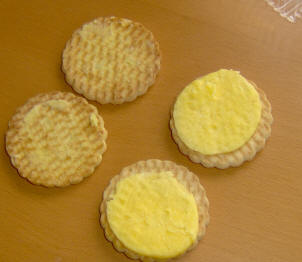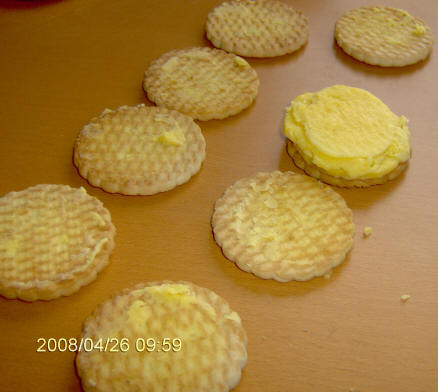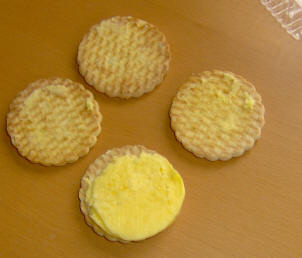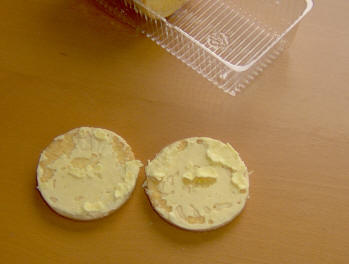RIKLBLOG
|
| Tomorrow |
| 26 April 2008 |
| Yesterday |
| Index |
| Eventide |
| SETI League |
| PriUPS Project |
| Bonus! |
| Contact |


The Sugar Harvest
One would think, after all these years, that little would remain to be learned about the Central Creme Theorem. But, as often occurs in the world of food activities, surprises remain. This one came from an unexpected source - The Girl Scouts.
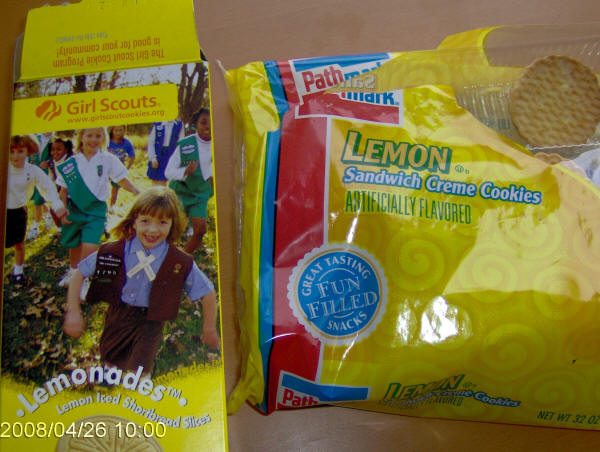
Not being a girl (or much of a scout), I never had the opportunity to sell "Girl Scout Cookies." Being a consumer of food, however, I have often purchased and eaten same, with greater (peanut butter) or lesser (graham cracker) pleasure. In the latter years I have had two purveyors of the Cookies - one at the office, one at home - hawking them. This year I noticed the availability of a new confection—see the left package. It took me a while to understand the theory behind it. The brief description was "Lemon Iced Shortbread Slices." And yet, when I scrutinized the photograph of the cookie, I saw only two layers. From studying the Central Creme Theorem, I made the blinkered assumption that this was a creme-center confection, similar to an Oreo or one of the artificially flavored Lemon Sandwich Creme Cookies in the right-hand package.
I Was Wrong, In a Potentially Delightful Way
Finally freeing myself of the creme-center prejudice, I realize that the Girl Scout Lemonades did not have a creme center, but rather had creme icing. The extraordinary utility of this feature leapt out at me. With the Lemonades I might no longer have to compound icing layers as I normally do with Oreos and others by laboriously de-sandwiching them. Here were cookies that were pre-exposed for my convenience. I immediately ordered some.
I planned a simple experiment. I would see how easy it was to concentrate the icing on this new confection, comparing it with the multi-levular but amenable Lemon Sandwich Creme Cookies as a control. The results are presented below.
|
|
Below: I was able to separate four cookies and combine the icing
into an almost-sufficient stratum. Note that this was
accomplished with four sequential, random samples. It
wasn't necessary to reject or discard any exemplars and no
precious filling was damaged during the photographic portion
of this exercise.
|
|||
|
Dispensing with the control subjects, at least one of which underwent further experiments with respect to solubility and reactivity, we move on to the Lemonades. I was hopeful that these subjects would exhibit the same lack of inter-layer adhesion, rendering them amenable to separation and stacking.
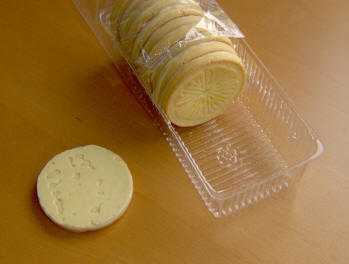 |
|
|
Tragically, it was not to be. Applying the same technique used with the controls, it was found that the layers could not be separated cleanly, leaving deposits both thinner and thicker than the original coating on both cookies. While each might arguably be used as a mock landscape for testing ground transport vehicles in an antstronaut program, they fail in the main experimental criterion of being able to deliver a thick stratum of sugar to the experimenter. Conclusion: Failure. Hypothesis refuted. |
|
One of the problems with "Science" is that people who do this for a living, instead of for an occasional sucrose augmentation, often do not report negative results. Doing so rarely enhances their career, and the agencies that provide grants look askance at continued groveling if nothing comes from it. I feel that much can be learned from negative results and deplore the reluctance of professionals to offer them for publication.
I would like to thank those who provided the experimental subjects. I checked and they all preferred that their names not be disclosed.
NP: "Apothecary" - Hazeldine
| © 2008 |
| Richard Factor |
